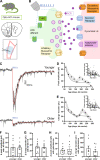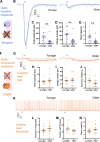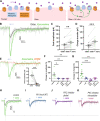Xanomeline restores endogenous nicotinic acetylcholine receptor signaling in mouse prefrontal cortex
- PMID: 36635596
- PMCID: PMC9938126
- DOI: 10.1038/s41386-023-01531-5
Xanomeline restores endogenous nicotinic acetylcholine receptor signaling in mouse prefrontal cortex
Abstract
Cholinergic synapses in prefrontal cortex are vital for attention, but this modulatory system undergoes substantial pre- and post-synaptic alterations during adulthood. To examine the integrated impact of these changes, we optophysiologically probe cholinergic synapses ex vivo, revealing a clear decline in neurotransmission in middle adulthood. Pharmacological dissection of synaptic components reveals a selective reduction in postsynaptic nicotinic receptor currents. Other components of cholinergic synapses appear stable, by contrast, including acetylcholine autoinhibition, metabolism, and excitation of postsynaptic muscarinic receptors. Pursuing strategies to strengthen cholinergic neurotransmission, we find that positive allosteric modulation of nicotinic receptors with NS9283 is effective in young adults but wanes with age. To boost nicotinic receptor availability, we harness the second messenger pathways of the preserved excitatory muscarinic receptors with xanomeline. This muscarinic agonist and cognitive-enhancer restores nicotinic signaling in older mice significantly, in a muscarinic- and PKC-dependent manner. The rescued nicotinic component regains youthful sensitivity to allosteric enhancement: treatment with xanomeline and NS9283 restores cholinergic synapses in older mice to the strength, speed, and receptor mechanism of young adults. Our results reveal a new and efficient strategy to rescue age-related nicotinic signaling deficits, demonstrating a novel pathway for xanomeline to restore cognitively-essential endogenous cholinergic neurotransmission.
© 2023. The Author(s).
Conflict of interest statement
The authors declare no competing interests.
Figures





Similar articles
-
Enhanced prefrontal nicotinic signaling as evidence of active compensation in Alzheimer's disease models.Transl Neurodegener. 2024 Dec 3;13(1):58. doi: 10.1186/s40035-024-00452-7. Transl Neurodegener. 2024. PMID: 39623428 Free PMC article.
-
Chrna5 is Essential for a Rapid and Protected Response to Optogenetic Release of Endogenous Acetylcholine in Prefrontal Cortex.J Neurosci. 2020 Sep 16;40(38):7255-7268. doi: 10.1523/JNEUROSCI.1128-20.2020. Epub 2020 Aug 14. J Neurosci. 2020. PMID: 32817066 Free PMC article.
-
Selective potentiation of (α4)3(β2)2 nicotinic acetylcholine receptors augments amplitudes of prefrontal acetylcholine- and nicotine-evoked glutamatergic transients in rats.Biochem Pharmacol. 2013 Nov 15;86(10):1487-96. doi: 10.1016/j.bcp.2013.09.005. Epub 2013 Sep 16. Biochem Pharmacol. 2013. PMID: 24051136 Free PMC article.
-
Cholinergic modulation of the cortical neuronal network.Pflugers Arch. 2003 Apr;446(1):17-29. doi: 10.1007/s00424-002-0999-2. Epub 2003 Mar 5. Pflugers Arch. 2003. PMID: 12690458 Review.
-
Nicotinic acetylcholine receptors in attention circuitry: the role of layer VI neurons of prefrontal cortex.Cell Mol Life Sci. 2014 Apr;71(7):1225-44. doi: 10.1007/s00018-013-1481-3. Cell Mol Life Sci. 2014. PMID: 24122021 Free PMC article. Review.
Cited by
-
Deficits in integrative NMDA receptors caused by Grin1 disruption can be rescued in adulthood.Neuropsychopharmacology. 2023 Nov;48(12):1742-1751. doi: 10.1038/s41386-023-01619-y. Epub 2023 Jun 22. Neuropsychopharmacology. 2023. PMID: 37349472 Free PMC article.
-
Medial prefrontal cortex acetylcholine signaling mediates the ability to learn an active avoidance response following learned helplessness training.Neuropsychopharmacology. 2024 Dec;50(2):488-496. doi: 10.1038/s41386-024-02003-0. Epub 2024 Oct 3. Neuropsychopharmacology. 2024. PMID: 39362985
-
Enhanced prefrontal nicotinic signaling as evidence of active compensation in Alzheimer's disease models.Transl Neurodegener. 2024 Dec 3;13(1):58. doi: 10.1186/s40035-024-00452-7. Transl Neurodegener. 2024. PMID: 39623428 Free PMC article.
-
A cholinergic circuit that relieves pain despite opioid tolerance.Neuron. 2023 Nov 1;111(21):3414-3434.e15. doi: 10.1016/j.neuron.2023.08.017. Epub 2023 Sep 20. Neuron. 2023. PMID: 37734381 Free PMC article.
-
The Role of Astrocytes in the Molecular Pathophysiology of Schizophrenia: Between Neurodevelopment and Neurodegeneration.Biomolecules. 2025 Apr 23;15(5):615. doi: 10.3390/biom15050615. Biomolecules. 2025. PMID: 40427508 Free PMC article. Review.
References
Publication types
MeSH terms
Substances
LinkOut - more resources
Full Text Sources

